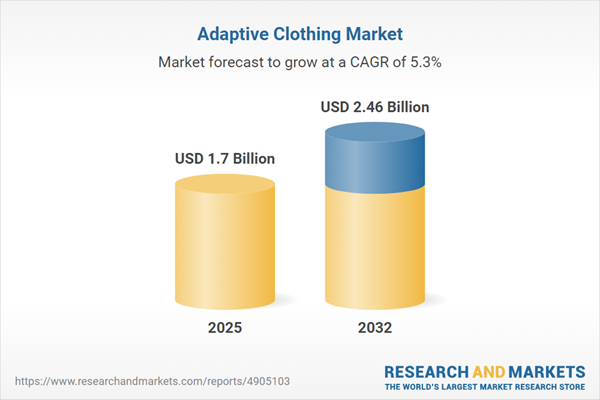Speak directly to the analyst to clarify any post sales queries you may have.
The adaptive clothing market is rapidly evolving as designers, manufacturers, and technology partners address diverse accessibility needs and emerging inclusion standards. Senior decision-makers must understand this dynamic marketplace to anticipate disruptive opportunities and effectively align long-term strategies.
Market Snapshot: Adaptive Clothing Market Growth and Outlook
The adaptive clothing market grew from USD 1.62 billion in 2024 to USD 1.70 billion in 2025. It is expected to continue expanding at a CAGR of 5.33%, reaching USD 2.46 billion by 2032. This trajectory highlights continued investment in innovative apparel solutions as awareness and regulatory support for inclusive design grow worldwide. The outlook signals both demand stability and enhanced market resilience across global regions, making the sector a priority for organizations seeking growth aligned with social impact.
Scope & Segmentation: Adaptive Clothing Market Analysis
- Product Types: Adaptive Accessories (including belts, straps, headwear, jewelry), Adaptive Bottoms (such as pants, shorts, skirts), Adaptive Tops (comprising blouses, jackets, shirts), Dresses & Gown, and Underwear & Intimates.
- Material & Fabric: Cotton, Polyester and blended fabrics, Spandex or Lycra, Specialized fabrics for flame resistance, protection, and moisture wicking.
- Age Groups: Adult (18-64), Senior (65+), Teen (13-17), Child (3-12), Infant (0-2).
- End User Categories: Adults (men and women), as well as pediatric segments (children, infants, toddlers).
- Distribution Channels: Offline retail (department stores, medical supply stores, specialty stores), Online options (brand websites, e-commerce platforms).
- Regions & Countries Covered: Americas (including North and Latin America), Europe, Middle East and Africa, Asia-Pacific—key contributor nations include the United States, Canada, China, India, Germany, United Kingdom, Japan, Brazil, South Africa, and more.
- Technology Integration: Advances such as virtual fitting rooms, augmented reality, smart textiles, moisture-responsive fibers, and sensor-enabled wearables are shaping design and user experience.
Key Takeaways for Senior Decision-Makers
- Adaptive clothing solutions now influence mainstream fashion strategy as the market shifts from niche to core apparel focus.
- Human-centered design and direct user involvement drive greater functionality and inclusiveness in product development cycles.
- Supply chains are pivoting toward localized micro-fulfillment and small-batch production to enhance responsiveness to regional demands and user specificity.
- Collaboration between technology specialists and traditional fashion brands is yielding adaptive wearables that integrate health monitoring, enhancing garment value.
- Global and cross-sector alliances—particularly among nonprofits, advocacy organizations, and academia—are accelerating market education and expanding potential end-user reach.
- Sustainable practices and transparent, ethical sourcing are becoming central to buyer and institutional trust, distinguishing forward-looking brands in this sector.
Tariff Impact on Adaptive Wear
Impending United States tariff adjustments are set to affect both raw material sourcing and finished product costs within the adaptive clothing sector. These changes may drive increased reliance on domestic supply chains or incentivize nearshoring to countries with favorable trade agreements. As cost pressures mount, stakeholders are expected to accelerate automation and invest in robotics and AI-driven quality control to sustain margin stability and maintain affordability for sensitive buyer groups.
Methodology & Data Sources
This research utilizes a multi-tiered framework. Data sources include interviews with industry leaders, site visits, structured channel partner surveys, and advanced sentiment analysis. Findings were rigorously validated with expert peer review and advisory-panel feedback to deliver reliable, actionable insights that support confident strategic decisions in adaptive clothing.
Why This Report Matters
- Enables executives to benchmark product portfolios and supply chain strategies against current market leaders driving innovation in adaptive clothing.
- Delivers actionable guidance on aligning design inclusivity, region-specific distribution, and organizational sustainability to capitalize on growing, high-impact market segments.
- Supports preparation for regulatory and tariff shifts, protecting organizational resilience and reinforcing consumer trust in a shifting global environment.
Conclusion
The adaptive clothing market presents strategic opportunities through inclusivity, collaboration, and advanced technology integration. Leaders who invest in innovation and ethical transparency are positioned to lead the evolving market and deliver lasting organizational and social value.
Additional Product Information:
- Purchase of this report includes 1 year online access with quarterly updates.
- This report can be updated on request. Please contact our Customer Experience team using the Ask a Question widget on our website.
Table of Contents
3. Executive Summary
4. Market Overview
7. Cumulative Impact of Artificial Intelligence 2025
Companies Mentioned
The companies profiled in this Adaptive Clothing market report include:- Tommy Hilfiger by PVH Corp
- Adidas AG
- Able2 Wear Ltd
- ABL Denim
- Adaptions by Adrian
- Adaptive Clothing Australia
- Buck & Buck, Inc.
- Création Confort
- Haxor
- JAM
- Joe & Bella
- MagnaReady, Inc.
- MAS Holdings
- Mode Eze Plus
- Professional Fit Clothing
- Raja Impex Pvt. Ltd.
- Silverts Universal Dressing Solutions, Inc
- The Able Label
- The LYCRA Company
- Abilitee Adaptive Wear
- Guangzhou Haoyu Garments Co., Ltd
- Primark Limited
Table Information
| Report Attribute | Details |
|---|---|
| No. of Pages | 189 |
| Published | October 2025 |
| Forecast Period | 2025 - 2032 |
| Estimated Market Value ( USD | $ 1.7 Billion |
| Forecasted Market Value ( USD | $ 2.46 Billion |
| Compound Annual Growth Rate | 5.3% |
| Regions Covered | Global |
| No. of Companies Mentioned | 23 |









